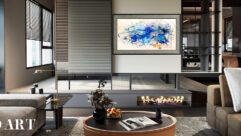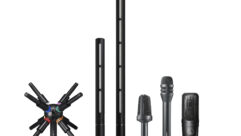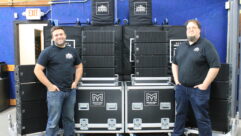Networked Digital Audio: State of the Art for the Arts
Jun 1, 2002 12:00 PM,
BY CHRISTIAN DOERING
DIGITAL AUDIO is still relatively new in many areas of sound reinforcement. For several years after the recording, production and distribution signal chain had become a digital domain, sound reinforcement professionals remained skeptical about the applicability of digital technology. To their credit, they were not concerned about cost versus revenue — the obstacle that continues to block widespread delivery of HDTV — but about reliability and dynamic range. The show must go on, after all, and it should sound great. Pioneering products such as Peavey’s MediaMatrix and BSS Audio’s Soundweb proved that digital signal processors had reached an acceptable tradeoff between flexibility and integrated functionality on the one hand, and basic performance and reliability on the other.
The success of those products in the marketplace posed a challenge for engineers developing second-generation digital audio systems: to provide an all-digital signal chain that eliminated tradeoffs altogether by providing superior performance and delivering all the key factors for a successful live event.
One team pursuing those goals is Biamp Systems. Based in Beaverton, Oregon, Biamp has developed several successful products for the conferencing environment over past few years, learning valuable lessons in the process about flexibility and adaptability through modular signal processing. Conferencing a multiroom, multisource environment has a distinctly different set of demands and signal flow architecture than, say, a rock concert. So when Biamp began developing a digital audio platform, the engineers (led by Matt Czyzewski, vice president of engineering and technical operations) knew they were faced with a project in adaptive engineering.
The results of what might be called a network-centric design are clearly apparent in the company’s Audia system, which has recently completed a successful beta test at Theater De Flint in Amersfoort, Netherlands. As an indication of the system’s success, the sound crew at Theater De Flint refused to let the two beta units leave the facility. As a result, Theater De Flint is now one of the first purchasers of a Biamp Audia system.
THE VENUE
located in the center of the Netherlands, Theater De Flint is a 20-minute drive from Amsterdam and half an hour from Utrecht. Originally built as a municipal multipurpose facility by the city of Amersfoort, the complex now operates as a private corporation. The facility includes a traditional proscenium theater with 880 seats and a multipurpose hall (the Stadshal), which a crew of six can reconfigure in about six hours (or less, depending on the use). The hall’s capacity ranges from 1025 to 1825, depending on setup. In addition, the Flint complex encompasses a restaurant, foyers and four meeting rooms.
Amersfoort sponsors several cultural events at the Flint each year. The rest of the time it is available for rental by concert promoters, corporations and so on. Major Dutch businesses such as ABN/AMRO Bank and KPN Telecom hold events at the Flint. Theaters such as the world-famous Nederlands Dans Theater, International Folkloristisch Dans Theater and the Lambda School of Performing Arts (a prestigious international drama academy) present productions in the Flint, as do musical acts such as Wadaiko Ichiro, Golden Earring and Ilse de Lange. The facility is also the host site for international conferences such as the Dutch Steel Institute. Audiences and attendees for many of these events come from all over the Netherlands, so the Flint is more than a regional cultural events center.
The broad range of clientele keeps the calendar full. The Flint’s various public spaces hosted 450 events last year. Maintaining this level of activity and the Flint’s status as a nationally known venue for the most prestigious clients requires, among other things, a sound system that is on the leading edge of technology. Although the Netherlands is a small country, centers such as the Flint can’t rely on geographical isolation to protect their market. They must stay on top of a highly competitive range of choices offered to promoters and event planners.
THE AUDIO SYSTEM
the audio system plays an important role in the Flint’s continued success, because in the Netherlands, even performers who tour with full production facilities prefer the balanced coverage of the house system in this multitiered hall. Ren’ de Lange, professional sales manager of Tannoy Netherlands, designed much of the current sound system and supervised its installation. He estimates that four out of five bookings in the Flint use the entire system, and all of them use the delays and fill speakers. The Flint’s system is capable of handling a wide range of program material and speech on its own. It also can easily adapt to external consoles, FOH stacks and monitors to accommodate the 20 percent of the clientele who opt to bring them.
- Distributed Transparency. “For theatrical productions, you should not hear the sound system at all,” said de Lange. “The audience should believe that the sound is coming from the performers or presenters.” To accomplish that, de Lange worked closely with the architects and builders at the Flint. The Theater hall in particular is an outstanding example of cooperation between all the stakeholders in the construction process. Together they strove to achieve a natural quality of reproduction that does not interfere with the communication between the stage and the audience.“The builder even had to change the placement of the main stage loudspeaker stacks,” de Lange said. “To make a tight bass without structural resonance, those loudspeakers (Tannoy S950s together with three 12-inch subs and 10-inch SuperDual full range speakers) are isolated from the stage floor with more than three cubic meters of fine white sand.” To further enhance the impression of the speakers’ aural transparency, they are hidden behind acoustically invisible scrims that match the color of the surrounding walls.
- The Stadshal. The Stadshal’s sound system was recently enhanced by supplementing the center cluster (Three Tannoy 10-inch SuperDuals and a Tannoy dual-15 sub) with left/right flown clusters of Tannoy 10-inch SuperDuals flanked by a pair of 12-inch subs in order to provide more SPL and low frequency energy. To ensure consistent level and frequency response throughout the hall, two delay rings are used: the inner delays are Tannoy 10-inch SuperDuals, while the outer delays are i12 Dual Concentric speakers. A left/right pair of i12s provides sidefill monitoring on stage.This design represents complex signal flow architecture with six separate zones and a total of 24 loudspeakers, each requiring its own crossover, limiting, EQ and delay functions. The multipurpose nature of the Stadshal makes the picture even more complicated. To provide the same unobtrusive yet highly intelligible sound — that must be earth-shaking at times — for all of the hall’s possible configurations, each speaker is on its own amplifier channel. To take advantage of all this flexibility, the signal processing must deliver a precisely configured signal to each left/right pair of those 24 amp channels, and be able to change between presets as quickly and easily as possible.
- The Theaterhal. The sound system in this hall is equally complex. De Lange’s design includes 10 zones. The main left/right clusters are four-way systems with Tannoy 10-inch SuperDuals, 12-inch bass units and dual-18 B950 subs. The center cluster uses a pair of Tannoy T300 12-inch SuperDuals and is supplemented by flown left/right clusters of i12s and T40 15-inch subs. Other zones include stage lip front fill (where CPA5 ICT speakers are used), a delay ring under the first balcony with more CPA’s mounted in the ceiling and side balcony fill (provided by four i8 Dual Concentrics). The first balcony has another delay ring with more ceiling-mounted CPA5s for the farther rows. The upper balcony has yet another delay ring of eight Tannoy i6s fed from the light bridge. Four Tannoy T12s are available for stage monitor functions. As in the Stadshal, the amplification is a mix of Chevin, C-Audio and Hill Chameleon units.
SIGNAL PROCESSING — REMOVING LIMITATIONS
dsp was obviously a requirement for this system: A design of this complexity in a space with this many possible configurations would not have been possible without it. De Lange’s original spec called for an Allen & Heath DR128 digital mix processor “with all the add-ons” in the Stadshal. The Allen & Heath unit has more inputs and fewer outputs than the Stadshal required, so some compromises were necessary in applying the proper delays to the various zones.
In the Theaterhal, BSS Omnidrives provided speaker management functions (EQ, crossover, limiting and delay) with a custom built matrix delivering the proper signals to each zone and amplifier channel. The system, though state of the art at the time, had some limitations. In particular, the Flint’s sound crew recognized that the dynamic range of first-generation DSP chips was not quite up to the requirements of the space, which features material that uses silence along with loud sound to achieve the desired artistic effect. Despite the care and attention paid to room construction, system design and loudspeaker placement, the system was not quite disappearing in many contexts.
So when Biamp notified its international distributors that it was seeking beta test sites for its new Audia system, de Lange immediately thought of the Flint. After some discussion with sound engineers Gert Venema and Ruud Lamers and technical manager Rob Bosch, a pair of Audia 4×12 units were installed, one in the Stadshal and the other 130 meters away in the Theaterhal. The 4-input, 12-output configuration chosen by the Flint fits well with the distributed sound system architecture: Audia is also available in 8×8 and 12×4 I/O configurations. In the Stadshal, the Allen & Heath DR128 has been upgraded to a Biamp Audia with 4 analog inputs and 12 outputs, in addition to a CobraNet 64-channel digital input. In the Theaterhal, a single Audia 4×12 replaces several OmniDrives and the custom matrix system.
Audia provides that DSP horsepower through six Analog Devices SHARC processors. Input/output options include the aforementioned A/D/A configurations, along with CobraNet input. Biamp is a full CobraNet licensee, and the Audia development team worked closely with Peak Audio to implement the CobraNet protocol in the new system. One result is that Audia units are capable of bidirectional audio signal routing using CobraNet’s deterministic protocol over an Ethernet network. Users of Soundweb or MediaMatrix will be familiar with Audia’s software design interface, which lets users build a complete system using drag-and-drop connections between a variety of signal processing functions. One major difference between Audia and other networked DSP systems is that the signal processing power is not constrained by hardware. All Audia units on the network are available to process any signal on the network. So in the initial design stage, the “DSP available” meter is absent. Instead, Audia’s compiler algorithm assigns DSP functionality among all units available on the network. When one Audia’s DSP capabilities are fully allocated, the software routes the signal to another unit for processing.
Gert Venema designed the signal flow within Audia. In the Stadshal, the 12 outputs are assigned as follows: three each to the main left and right clusters for a total of six, and one each to the left, center and right flown systems, the two delay rings and the stage fill systems. The four inputs can be assigned to left/center/right/sub outputs from the Allen & Heath GL4000 console. In between, Venema used Audia’s DSP power to implement a matrix mixer that connects a variety of delays, parametric equalizers with as many as 18 bands, crossovers, compressor/limiters, level controls and meters — 86 virtual devices in all for the Theaterhal.
Each system element can now be addressed from the staff’s office over an Ethernet LAN. Audia’s control software runs over Ethernet, and each Audia requires two Cat-5 copper or UTP optical fiber connections to the nearest Ethernet hub or switch, one for CobraNet digital audio and one for Ethernet control information. Once the two networks are delivered to the routing point, however, they can run on the same cable. At Theater de Flint, the distance spanned between the two halls is 130 meters, yet a system operator in one hall can monitor or adjust the system in the other hall without moving. Even more useful, from the Flint technical staff’s point of view, is that Ethernet control enables them to change presets from their offices, without going into the halls themselves. Adding to the system’s integration, the CobraNet link allows the program in one hall to be sent to the other, so that overflow audiences can hear what’s going on in the other main hall or technicians can monitor the sound from a remote location.
BETTER AUDIO QUALITY, MORE FLEXIBILITY
the time, money and attention to detail lavished on the Flint’s two performance spaces have paid off. The technical staff is pleased with the results, so much so that it bought the two beta units at the end of the test period. Visiting sound engineers have also been impressed with Audia’s performance and ease of use. In the Theaterhal, the sound is “much more open and more defined,” according to de Lange. The Stadshal has benefited from Audia’s additional signal processing power, as well. “We can now implement a proper matrix,” de Lange said, “with cross-point delays that allow us to use the Haas precedence effect at every seat, so that the sound always appears to be coming from the stage.” Audia’s combination of DSP processing power, CobraNet networking and Ethernet control allow these complex matrices to be reconfigured remotely from the theater offices. It still takes about six hours to rearrange the seating, but configuring the sound system can now be accomplished in seconds.
Measurements are taken each year in the two halls to verify the sound system’s performance. The most recent set was accomplished with Br’el & Kjaer microphones, MLSSA, SPL meters and an AudioControl analyzer. In the Theaterhal, direct SPL is 109 dB and 113 dB in the reverberant field. Peaks of 120 dB are possible at the mix position, but most of the system presets limit the output to well below this damaging level. The seating area as a whole measures a %Alcons of 4 percent, with the worst case (in the rear of the first balcony) measuring only 7 percent. The Stadshal system reaches 110 dB SPL in the direct field and 120 dB in the reverberant field. On the ground floor, %Alcons measures at 8 percent.
- Digital Comes Of Age. Performance measurements and user feedback show that the second generation of DSP devices is more than capable of meeting the highest standards set by analog-based sound reinforcement systems. In fact, the implementation of a digital network can significantly enhance performance in several areas without imposing a cost penalty. For example, the Audia units at the Theater de Flint can deliver multiple channels of highly processed audio using a single cable run and conduit. The addition of multiple levels of complex signal processing doesn’t introduce signal degradation, because floating-point SHARC processors perform the functions in the digital domain. Ethernet control and software-based architecture allow Theater de Flint’s technical staff to set up and control a complex distributed sound system with complete precision and to adapt that system to a wide range of program material in seconds. With benefits like that, it’s hardly surprising that Theater de Flint decided to purchase the Biamp Audia system. No doubt it will have lots of company in coming years.
As marketing partner at Dynamic Market Systems in San Rafael, California, Christian Doering provides consulting and brand-building services to audiovisual technology companies. For more information about Audia or the installation at the Theater de Flint, contact Graeme Harrison, vice president of international sales at[email protected].
Video at Theater De Flint
Video projection in the facility comes from an Eiki LCD projector. For video monitoring, four monitors cover the two public foyers and the artist dressing rooms. Panasonic cameras in the Theaterhal’s control room and the Stadshal’s light bridge are aimed at the stages. Video is controlled using a Panasonic editing suite.
For More Information
Allen & Heath
allen-heath.com
□ 221
Analog Devices
analog.com
é 222
AudioControl
audiocontrol.com
□ 223
Biamp Systems
biamp.com
□ 224
Brüel & Kjaer
bksv.com
□ 225
BSS Audio
bss.co.uk
□ 226
C-Audio
c-audio.com
□ 227
Chevin
chevin-research.com
□ 228
Eiki
eiki.com
□ 229
Malcolm Hill Associates
□ 230
Panasonic
panasonic.com
□ 231
Peak Audio (CobraNet)
peakaudio.com
□ 232
Peavey
peavey.com
□ 233
Tannoy
tannoy.com
□ 234
□ = Circle this number on Reader Service Card for more information.










